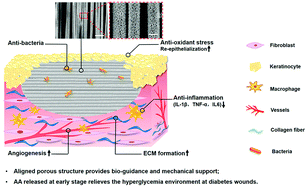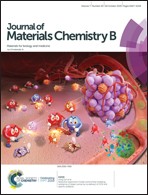An aligned porous electrospun fibrous scaffold with embedded asiatic acid for accelerating diabetic wound healing†
Abstract
The diabetic non-healing wound is one of the most common complications of diabetics. The long-term stimulus of oxidative stress, inflammation and infection caused by the hyperglycemic microenvironment in the wound site always leads to a delayed healing process of the diabetic wound. To address this issue, in this study, we prepared an asiatic acid (AA)-embedded aligned porous poly(L-lactic acid) (PLLA) electrospun fibrous scaffold (AA-PL) for accelerating diabetic wound healing. The results showed that the electrospun fibers with nanopores on the surfaces were aligned in a single direction, while the AA was well embedded in the fibers and can be continuously released from them. The in vitro results revealed that the AA-PL scaffolds can effectively alleviate the H2O2-induced oxidative stress damage to HaCat cells and downregulate the LPS-induced pro-inflammatory cytokine (IL-1β, TNF-α, IL6) gene expression in RAW 264.7 macrophage cells. Moreover, the growth of E. coli and S. aureus could be inhibited by the AA-PL scaffolds. The in vivo study further demonstrated that the AA-PL scaffolds can accelerate the re-epithelization, angiogenesis and extracellular matrix formation of a wound by relieving the high oxidative stress, inflammation and infection in the diabetic wound site. This study suggests that the combination of hierarchical structures (nanopores on the aligned fibers) with the controllable release of AA from the scaffolds is an efficient and innovative strategy for the treatment of diabetic non-healing wounds.



 Please wait while we load your content...
Please wait while we load your content...